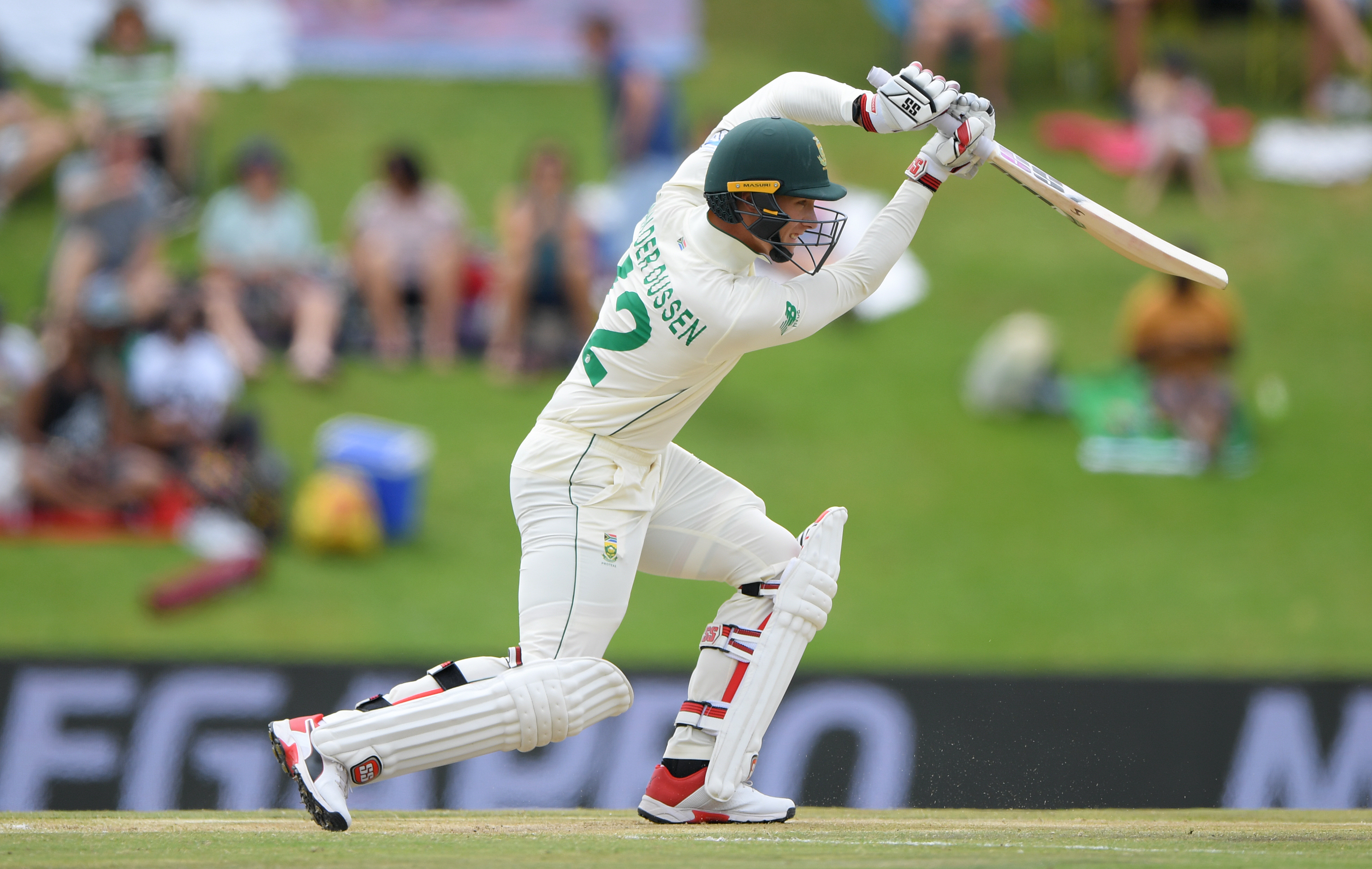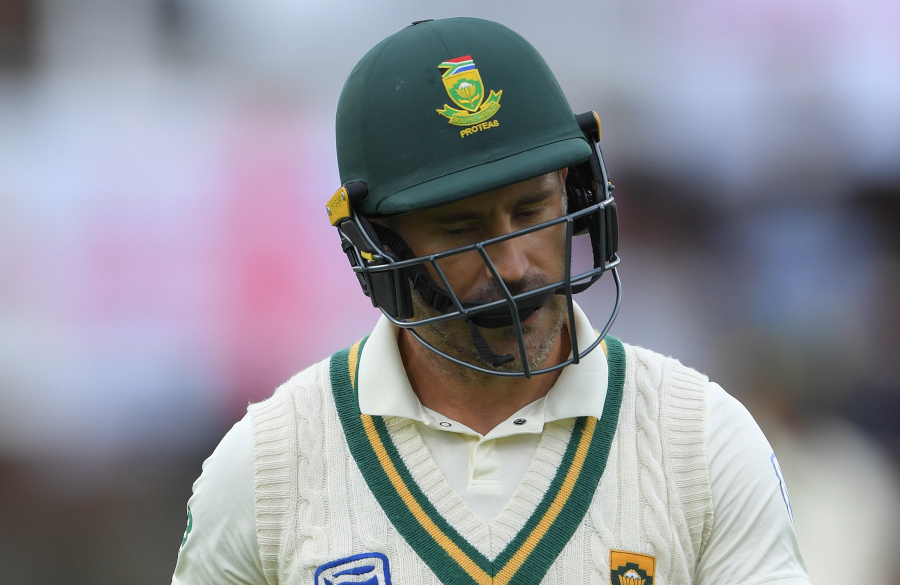In the bosom of the great Unity Stand at the Wanderers there is a long line of glass encasements honouring triumphs of the past, writes DANIEL GALLAN.
The ‘Mean Machine’, that all-conquering Transvaal side of Clive Rice, Jimmy Cook and Ray Jennings, is remembered. As is the ‘438’ game against Australia in 2006, the first-ever T20 World Cup final in 2007, and AB de Villiers’ spectacular 149 off 44 balls against the West Indies in 2015.
For much of Monday, it looked like Rassie van der Dussen would get an entire booth all to himself. For 198 minutes at the crease, he played with a combination of confidence and composure that has rarely been seen from a willow-wielder sporting a Protea over his heart.
At one point Mark Wood hit him flush on the chest, close to that Proteas badge, but he remained resolute. He had already survived an lbw review when he was yet to score after four balls. He had already seen off probing spells from Sam Curran and Chris Woakes, cutting with a wafting raised leg and pulling with the aggression of a street dog.
He had already hit the part-time spin of Joe Root and Denly out of the attack with reverse sweeps and bludgeons over midwicket and biffs down the ground. He had already combined with his captain Faf du Plessis in a 92-run stand for the third wicket in an epic run chase.
He’d also just hit Ben Stokes through extra cover and Wood past backward point to enter the 90s.

Two balls after Van der Dussen was hit, Du Plessis was out. Stokes’ magical arm directed the ball towards a full length and brought the South African captain forward. The ball bit into the surface and stayed there for a moment before keeping low. Du Plessis prodded away from his body and was bowled via an edge off the toe end of his bat.
But Van der Dussen endured and bunted Stokes to the mid-on fence with a high elbow and a full bat face. A single off the next ball took him to 98.
He was just one hit away from becoming the 146th South African with a Test century to his name. One hit from vindicating the selectors’ decision in handing a debut to a 30-year-old with a decent, but unspectacular, first-class average of 43.8. One hit from the crowning moment of his career that has seen him ply his trade in Canada and the Caribbean.
All this must have been clouding his thoughts as he lined up Wood on his 138th delivery faced. The ball was full, but not that full, and he leaned in with all the intent of a man grasping at a milestone. For the first time in his knock he unfurled a drive to a rising ball and met it with the top half of his bat. A dull thud rather than a crisp thwack emanated from his blade and the world stopped spinning as the ball nestled into Stuart Broad’s spindly hands at short cover.

Even if the crowd was filled with jingoistic Joburgers baying for blood, the only sound you would have heard was that of whooping English fans and players. Sickeningly, almost cruelly, Van der Dussen had fallen two short of his ton. Cricket had once again spat in the face of romance.
Van der Dussen took an age to leave the field. He reluctantly acknowledged the sparse crowd’s applause. He pressed his bat against his helmet, contemplating the myriad of alternative realities where he was a centurion and still hauling his country to an improbably victory.
As it was, he departed with his side on 187-3 just before tea. Less than two hours later, South Africa were bowled out for 274. England had won the Test by 191 runs and with it claimed the four-match series 3-1. These lopsided scorelines flatter and deceive no one. It is an accurate reflection of the gulf that exists between the two teams.
Anrich Nortje bowled with aggression and pace and claimed a first-ever five-wicket haul in England’s first innings, but he never quite matched the ferocity of Wood. Beuran Hendricks also grabbed a first-ever five-for in England’s second dig, but never exerted the sustained pressures of Broad, Curran or Woakes. South Africa’s top order showed signs of improvement, but it is fitting that a Protea fell two short of a 100 when three Englishmen passed triple figures over the last two months.
We’ve been told that this is a team in transition. Vernon Philander is gone and so are his ridiculous numbers of 224 wickets from 64 matches at an average of 22.32. Other senior players – Dean Elgar and Du Plessis with the bat, Kagiso Rabada with the ball – have let the team down with below-par performances or irresponsible behaviour. More must be expected from these leading figures if the Proteas are to emerge on the other side of this dark tunnel.
The American artificial-intelligence researcher Eliezer Yudkowsky argued, ‘There is no justice in the law of nature.’ At this cathedral of cricket that is as much a homage to the elements as it is an area for professional sport, South Africa got what they deserved.

There was no justice for the home fans desperate for something to feel good about. The travelling English fans who get fat on our steaks and beer and enjoy the privilege of being born in a country that grants them almost 20 rand to their pound will return home with smiles on their red faces.
Perhaps it is a good thing that Van der Dussen did not carry the side to a world-record chase. What would that have accomplished apart from the papering over cracks that have no grown into vast, yawning chasms. Without that thin veneer, Mark Boucher and Graeme Smith and the rest of the suits at Cricket South Africa (CSA) must now look down into the enveloping abyss and plot a way back up.
The side is still alarmingly white. Only one black African was on the field at any one time throughout the series and at no point did CSA meet their own transformation targets. Black fans are getting angrier and rightfully so. We should all be angry that a team has the temerity to claim it represents our country in 2020 but appear as lily white as it did two decades ago.
Sponsors need to be wooed back. Fans need to be won back. The Kolpak conundrum needs to be untangled and the maladministration at CSA HQ needs to be rectified.
This defeat by England, those former colonisers whose empire has long faded but who still plant their flags in cricket grounds around the world, will hurt. But if this stadium has taught us anything it is that this game offers despair and elation in equal measure.
That is why there are monuments encased in glass in the bosom of the Unity Stand. That is why we keep coming back. For the hopeless causes and the crushing defeats. We come back because the bad times make the good times feel better. When they return, remains a mystery.
Photo: Gallo Images







